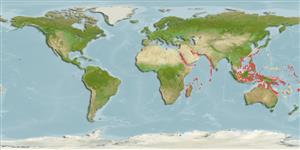>
Anguilliformes (Eels and morays) >
Muraenidae (Moray eels) > Muraeninae
Etymology: Gymnothorax: Greek, gymnos = naked + Greek, thorax, -akos = breast (Ref. 45335).
More on author: Smith.
Environment: milieu / climate zone / depth range / distribution range
Ecología
marino demersal. Tropical
Distribución
Países | Áreas FAO | Ecosistemas | Ocurrencias, apariciones | Point map | Introducciones | Faunafri
Indo-West Pacific: Mozambique and Mauritius (Ref. 33390); Oman (Ref. 11441); Philippines south to Australia, east to Papua New Guinea (Ref 90102).
Tamaño / Peso / Age
Maturity: Lm ? range ? - ? cm
Max length : 46.0 cm TL macho / no sexado; (Ref. 3257)
Short description
Morfología | Morfometría
Vértebra: 166 - 170. Pale yellow, lighter ventrally (Ref. 3257). Dorsal margin light blue (Ref. 3257).
Found in sand or rubble bottoms. Also in Shallow water, often in tidepools (Ref 90102). Nocturnal, feeds on small reef organisms (Ref. 68964).
Life cycle and mating behavior
Madurez | Reproducción | Puesta | Huevos | Fecundidad | Larva
Castle, P.H.J. and J.E. McCosker, 1986. Muraenidae. p. 165-176. In M.M. Smith and P.C. Heemstra (eds.) Smiths' sea fishes. Springer-Verlag, Berlin. (Ref. 3257)
IUCN Red List Status (Ref. 130435)
Threat to humans
Harmless
Human uses
Más información
Age/SizeCrecimientoLength-weightLength-lengthLength-frequenciesMorfometríaMorfologíaLarvaDinámica larvariaReclutamientoAbundanciaBRUVS
ReferenciasAcuiculturaPerfil de acuiculturaRazasGenéticaElectrophoresesheritabilidadEnfermedadesProcesamientoNutrientsMass conversion
ColaboradoresImágenesStamps, Coins Misc.SonidosCiguateraVelocidadTipo de nataciónSuperficie branquialOtolitosCerebrosVisión
Herramientas
Special reports
Download XML
Fuentes de Internet
Estimates based on models
Preferred temperature (Ref.
123201): 25 - 29.3, mean 28.3 °C (based on 2754 cells).
Phylogenetic diversity index (Ref.
82804): PD
50 = 0.5000 [Uniqueness, from 0.5 = low to 2.0 = high].
Bayesian length-weight: a=0.00047 (0.00025 - 0.00089), b=3.28 (3.13 - 3.43), in cm total length, based on LWR estimates for this Genus-body shape (Ref.
93245).
Nivel trófico (Ref.
69278): 4.0 ±0.66 se; based on food items.
Resiliencia (Ref.
120179): Medio, población duplicada en un tiempo mínimo de 1.4-4.4 años (Preliminary K or Fecundity.).
Fishing Vulnerability (Ref.
59153): Moderate vulnerability (36 of 100).
